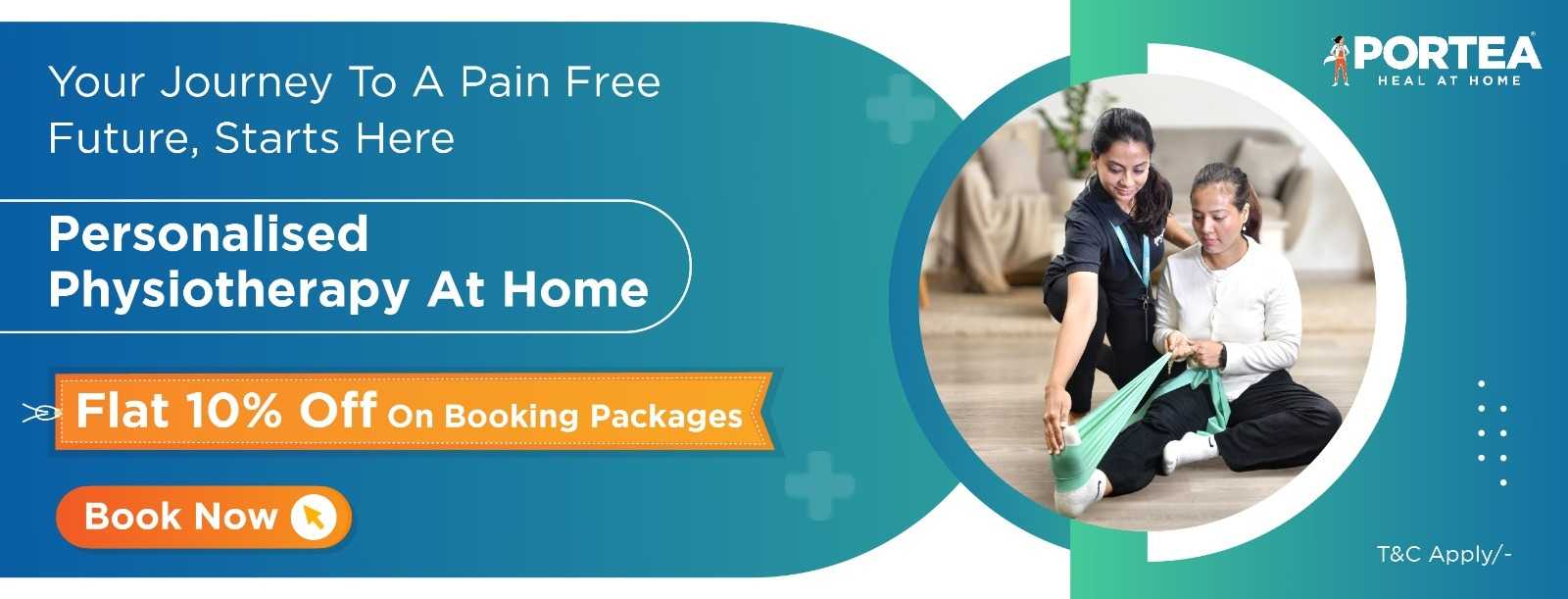
Expert Physiotherapy at Home
Certified physiotherapists visit you at home to provide focused, one-on-one care tailored to your needs. With no travel or waiting rooms, recovery happens in a setting that is comfortable, familiar, and built around your convenience.
Personalised Recovery Programmes
Every treatment plan is designed to suit your condition, goals, and pace. Our physiotherapists follow structured, evolving protocols to ensure consistent progress, with each session aligned to deliver meaningful results.
Trusted Physiotherapists. Real Results.
Our team comprises experienced, background-verified physiotherapists trusted by thousands of families. With a strong focus on safety, reliability, and clinical outcomes, we make recovery at home both effective and reassuring
Patient Testimonials
Portea Physiotherapists for Home Visits
Meet some of our experienced and dedicated healthcare professionals

Dr. Lokesh G
Physiotherapist
Specializations
Experienced in Neurological rehabilitation, Orthopaedic physiotherapy, and Paediatric care
Delivers structured, high-impact treatment plans across neuro, ortho, and paediatrics—ensuring safety, comfort, and measurable recovery at every stage.

Dr. Mohammed Sarwar
Physiotherapist
Specializations
Experienced in Neurological rehabilitation, Adult physiotherapy, and Paediatric care
Combines deep clinical expertise with a compassionate approach, supporting both adults and children through neuro and physical rehabilitation that promotes long-term independence and recovery.

Dr. Nelapati Divya
Physiotherapist
Specializations
Skilled in Orthopaedic rehabilitation, Manual therapy techniques, and Paediatric physiotherapy
Brings a personalised, hands-on approach to healing—combining structural expertise with paediatric sensitivity to restore movement, relieve pain, and improve everyday function.

Dr. Naveen V
Physiotherapist
Specializations
Trained in Pain management, Cardiac and Orthopaedic rehabilitation, Neurological care, and Neural tissue mobilisation
Brings clinical precision and empathy together—designing science-backed recovery protocols for pain relief, nerve mobilisation, and cardio-neuro-ortho rehabilitation across all age groups

Dr. Miloni Savla
Physiotherapist
Specializations
Holds an MPT in Orthopaedics with a focus on Musculoskeletal rehabilitation and strength recovery
Delivers focused, movement-oriented therapy grounded in orthopaedic science—helping patients rebuild strength, restore function, and return to daily life with confidence

introduction
Thoracic Outlet Syndrome (TOS) is a condition caused by the compression of nerves, arteries, or veins in the thoracic outlet—the space between the collarbone and the first rib. This compression can lead to pain, numbness, and weakness in the neck, shoulders, arms, and hands. TOS is often linked to poor posture, repetitive arm movements, anatomical abnormalities, or trauma. If left untreated, it can significantly affect daily activities and overall quality of life. Early diagnosis and targeted treatment are essential for managing symptoms effectively and preventing long-term complications.
types of thoracic outlet syndrome
TOS is categorized into three main types, depending on the structures affected:
- Neurogenic TOS (NTOS): The most common form, accounting for over 90% of cases, results from compression of the brachial plexus nerves, leading to pain, tingling, and weakness in the arm and hand.
- Venous TOS (VTOS): Caused by compression of the subclavian vein, leading to swelling, bluish discoloration, and blood clot formation in the arm.
- Arterial TOS (ATOS): The rarest type, caused by compression of the subclavian artery, resulting in cold sensitivity, pallor, and reduced pulse in the affected limb.
recognizing the warning signs of thoracic outlet syndrome
The symptoms of TOS vary based on the type but generally include:
- Pain and tingling: Often felt in the neck, shoulders, arms, or hands, worsening with certain activities.
- Weakness and muscle fatigue: Difficulty gripping objects or performing overhead tasks.
- Swelling and discoloration: Especially in venous TOS, where the affected arm may appear bluish or swollen.
- Cold sensitivity and poor circulation: Seen in arterial TOS, where the hand may feel unusually cold or turn pale.
- Limited range of motion: Difficulty raising the arms or persistent stiffness.
understanding the causes of tos
Several factors contribute to the development of TOS, including:
- Poor posture: Forward head posture or rounded shoulders increase pressure on the thoracic outlet.
- Repetitive movements: Frequent overhead activities in sports (e.g., swimming, baseball) or occupations (e.g., painters, hairstylists) heighten the risk.
- Trauma or injury: Whiplash from car accidents or fractures can lead to structural changes causing compression.
- Anatomical variations: Extra cervical ribs or tight scalene muscles can narrow the thoracic outlet.
- Carrying heavy loads: Backpacks or shoulder bags that strain the upper body.
who is at risk?
Certain individuals are more prone to developing TOS. Risk factors include:
- Athletes engaging in repetitive shoulder movements: Swimmers, baseball pitchers, and weightlifters.
- Workers with overhead tasks: Carpenters, electricians, and factory workers.
- Individuals with poor ergonomics: Prolonged slouching or improper workstation setup.
- People with congenital abnormalities: Extra ribs or tight fibrous bands restricting space in the thoracic outlet.
- History of trauma: Prior neck or shoulder injuries increasing susceptibility.
diagnosis and treatment approaches for tos
Diagnosing TOS involves a comprehensive medical history review, physical examination, and imaging tests such as X-rays, MRIs, or nerve conduction studies to assess nerve compression.
Conservative Treatment Options:
- Postural correction: Adjusting body alignment to relieve pressure on compressed structures.
- Stretching and strengthening exercises: Targeting the neck, shoulder, and chest muscles to improve mobility and reduce nerve irritation.
- Pain management: Nonsteroidal anti-inflammatory drugs (NSAIDs) or muscle relaxants for symptom relief.
- Physical therapy: Hands-on techniques, ultrasound therapy, and guided exercises to restore function.
- Activity modifications: Avoiding repetitive motions that worsen symptoms.
Surgical Intervention:
In severe cases where conservative treatments fail, surgery may be necessary. Procedures include:
- First rib resection: Removing the first rib to create more space for nerves and blood vessels.
- Scalene muscle release: Releasing tight muscles compressing the thoracic outlet.
- Vascular bypass surgery: Used in arterial TOS to improve blood flow.
physiotherapy: a key component of recovery
Physiotherapy plays a critical role in managing TOS, focusing on relieving nerve compression, improving posture, and strengthening the affected muscles. A well-designed physiotherapy program includes:
- Postural training: Correcting forward head and rounded shoulder posture.
- Stretching routines: Targeting tight muscles like the scalene, pectoral, and trapezius muscles.
- Nerve gliding exercises: Helping the brachial plexus move freely within the thoracic outlet.
- Strengthening exercises: Enhancing shoulder stability and mobility.
- Ergonomic adjustments: Educating patients on proper workstation setup and daily habits to reduce strain.
lifestyle modifications to prevent tos
To reduce the risk of TOS or prevent symptom recurrence, consider:
- Maintaining good posture: Keeping the shoulders back and the head aligned.
- Avoiding prolonged overhead activities: Taking breaks during repetitive motions.
- Using ergonomic workspaces: Adjusting desk height, keyboard placement, and chair support.
- Incorporating regular stretching: Performing mobility exercises to prevent muscle tightness.
- Strength training: Strengthening shoulder and neck muscles to support proper alignment.
how portea supports tos management
At Portea, we provide home-based physiotherapy solutions tailored for Thoracic Outlet Syndrome. Our expert physiotherapists design personalized rehabilitation programs focusing on postural correction, pain relief, and functional improvement.
Beyond TOS management, we specialize in various physiotherapy services, including post-surgical rehabilitation, arthritis care, neuro-rehabilitation, sports injury recovery, orthopedic care, elderly physiotherapy, and respiratory therapy. With our dedicated team, we ensure that each patient receives expert, customized care in the comfort of their home, helping them regain strength and mobility while improving their overall quality of life.
faqs
1.What are the types of Thoracic Outlet Syndrome?
There are three types: Neurogenic TOS (nerve compression), Venous TOS (vein compression), and Arterial TOS (artery compression). Neurogenic TOS is the most common, causing pain, numbness, and muscle weakness.
2.What are common risk factors for TOS?
Poor posture, repetitive arm movements, trauma (such as whiplash), anatomical abnormalities, and carrying heavy loads frequently can increase the risk of developing TOS.
3.Can Thoracic Outlet Syndrome be treated without surgery?
Yes, many cases improve with physical therapy, posture correction, pain management, and lifestyle modifications. Surgery is considered only if symptoms persist despite conservative treatments.
4.How can I prevent Thoracic Outlet Syndrome?
Maintaining good posture, avoiding repetitive overhead movements, strengthening shoulder muscles, and stretching regularly can help prevent nerve or blood vessel compression in the thoracic outlet.
5.What are the early signs of Thoracic Outlet Syndrome?
Early signs include neck and shoulder discomfort, tingling in the fingers, arm weakness, and occasional swelling. Symptoms often worsen with prolonged arm elevation or repetitive movements.
6.Is Thoracic Outlet Syndrome a serious condition?
TOS can range from mild discomfort to severe cases affecting circulation or nerve function. If left untreated, it may lead to muscle atrophy, blood clots, or chronic pain.
Doctor Consultation
Nursing
Physiotherapy
Trained Attendant
Elder Care
Mother & Baby Care
Lab Tests
Medical Equipment
Speciality Pharma
Critical Care





